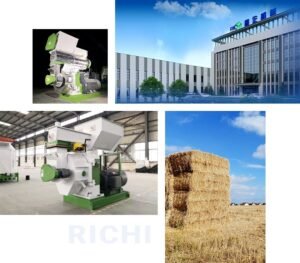
A 35 tons per hour (t/h) commercial feed mill operates in a competitive and dynamic market where the choice of sales channels can significantly influence its annual sales revenue. Understanding how different sales channels affect revenue is crucial for strategic planning and maximizing profitability. This article explores the various sales channels available for a 35t/h feed mill and their impact on annual sales revenue.
Key Sales Channels for a 35t/h Feed Mill
- Direct Sales to Large-Scale Farms
- Distributor Network
- Retail Outlets
- E-commerce Platforms
- Cooperative Partnerships
- Government and Institutional Contracts
- Export Markets
- Private Label Manufacturing
1. Direct Sales to Large-Scale Farms
Description:
Direct sales involve selling feed products directly to large-scale farms, including poultry, cattle, and swine farms. This channel is particularly effective for high-capacity feed mills due to the large volume of feed required by such operations.Impact on Revenue:
- High Volume Sales: Direct sales to large farms typically result in high-volume orders, contributing significantly to annual sales revenue.
- Lower Marketing Costs: Direct relationships with farms reduce the need for extensive marketing efforts.
- Stable Demand: Long-term contracts with large farms can provide stable and predictable revenue streams.
Example:
A 35t/h feed mill securing contracts with several large poultry farms can ensure consistent demand and high-volume sales, leading to substantial annual revenue.
Related post:feed pellet production line
2. Distributor Network
Description:
Establishing a network of regional distributors helps the feed mill reach a wider market, including smaller farms and geographically distant regions.
Impact on Revenue:
- Expanded Market Reach: Distributors can help penetrate markets that are difficult to reach directly.
- Volume-Based Pricing: Sales through distributors may involve volume-based pricing, which can affect profit margins but increase overall sales volume.
- Shared Marketing Efforts: Distributors often handle local marketing, reducing the feed mill’s marketing expenses.
Example:
Partnering with distributors across different regions can significantly increase the feed mill’s market presence and sales volume, contributing positively to annual revenue.
3. Retail Outlets
Description:
Selling feed products through retail outlets, such as agricultural supply stores, targets small-scale farmers and hobby livestock owners.
Impact on Revenue:
- Higher Margins: Retail sales often command higher margins compared to bulk sales.
- Brand Visibility: Presence in retail outlets enhances brand visibility and recognition.
- Diverse Customer Base: Access to a broader customer base, including small-scale and hobby farmers.
Example:
Stocking feed products in major agricultural supply chains can boost brand visibility and attract a diverse customer base, increasing annual sales revenue.
4. E-commerce Platforms
Description:
E-commerce platforms offer a modern sales channel, allowing the feed mill to sell products online directly to customers.Impact on Revenue:
- 24/7 Accessibility: Online platforms provide round-the-clock accessibility to customers, increasing sales opportunities.
- Reduced Overhead: Lower overhead costs compared to physical retail outlets.
- Wider Reach: Ability to reach customers in remote or underserved areas.
Example:
Launching an e-commerce platform for feed products can attract tech-savvy farmers and expand the customer base, contributing to higher annual sales revenue.
5. Cooperative Partnerships
Description:
Forming partnerships with agricultural cooperatives provides access to a large network of farmers and livestock producers.Impact on Revenue:
- Bulk Sales: Cooperatives often purchase in bulk, leading to high-volume sales.
- Enhanced Credibility: Partnerships with respected cooperatives can enhance the feed mill’s credibility and market reputation.
- Collaborative Marketing: Joint marketing efforts with cooperatives can reduce marketing expenses.
Example:
Collaborating with a major agricultural cooperative can secure bulk orders and enhance market credibility, positively impacting annual sales revenue.
6. Government and Institutional Contracts
Description:
Securing contracts with government agencies, research institutions, and large-scale livestock operations provides stable, high-volume sales channels.
Impact on Revenue:
- Stable Revenue: Long-term contracts with government and institutional clients provide predictable revenue streams.
- Reputation Boost: Association with reputable institutions can enhance market reputation.
- High Volume: Large-scale contracts often involve significant volumes, contributing substantially to annual revenue.
Example:
Winning a government contract to supply feed for a national livestock program can ensure stable demand and high-volume sales, boosting annual revenue.
7. Export Markets
Description:
Exploring export markets can significantly expand the customer base and increase sales revenue.
Impact on Revenue:
- Market Diversification: Access to international markets diversifies revenue sources and reduces dependency on domestic markets.
- Higher Margins: Certain export markets may offer higher prices and better margins.
- Currency Exchange: Favorable exchange rates can enhance revenue from exports.
Example:
Exporting feed products to high-demand markets in neighboring countries can diversify revenue streams and increase annual sales revenue.
8. Private Label Manufacturing
Description:
Producing feed for other brands or retailers under private label agreements can be an effective way to utilize production capacity.
Impact on Revenue:
- Utilization of Excess Capacity: Private label manufacturing helps utilize excess production capacity.
- Stable Contracts: Long-term private label contracts provide stable revenue streams.
- Reduced Marketing Costs: Private label agreements often involve lower marketing expenses.
Example:
Partnering with a major retail chain to produce private label feed products can ensure stable demand and consistent revenue, positively impacting annual sales revenue.
Conclusion
The choice of sales channels for a 35t/h feed mill factory significantly impacts its annual sales revenue. By strategically leveraging direct sales, distributor networks, retail outlets, e-commerce platforms, cooperative partnerships, government and institutional contracts, export markets, and private label manufacturing, the feed mill can optimize its market reach and revenue potential.Each sales channel offers unique advantages and challenges, and a balanced approach that combines multiple channels can provide the best results. By understanding the dynamics of each channel and adapting strategies accordingly, a 35t/h feed mill factory can achieve stable and sustainable revenue growth in a competitive market environment.





